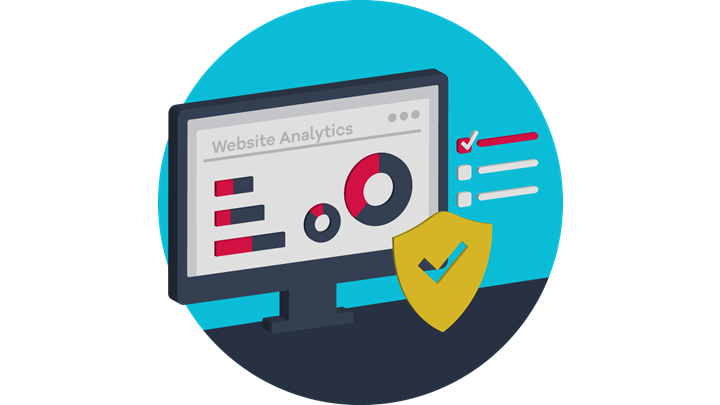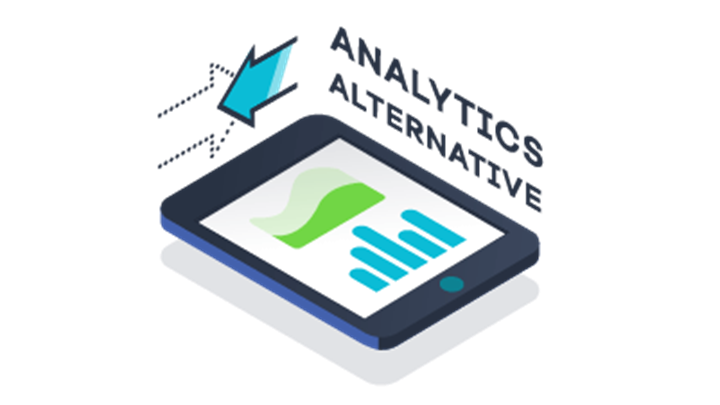Should you consider a Google Analytics alternative?
Google Analytics needs little introduction.
It’s a widely used website analytics tool that helps measure the performance of your inbound marketing channels and on-site behavior of your visitors.
Yet Google Analytics is far from the only analytics tool out there. Competing software is often easier to use or offers features that Google Analytics lacks.
That’s why for many companies, it makes sense to look into alternatives to Google Analytics.

Why use an analytics tool?
Identifying what works and what doesn’t
Website analytics solutions not only tell you how well your site is performing but also details which pages are performing better than the others. There are always certain pieces of content or specific pages that attract more attention than the rest. A customizable website analytics software can generate a guide for the creation of a path to conversion. It can help you identify the trouble-spots and determine where your individual visitors go after hitting those trouble-spots.
Setting up behavior maps and predicting buyer pathways
An excellent and updated web analytics platform should let you take a glimpse at your website from your visitors' perspectives. Look for behavior maps in your analytics tools to understand what your visitors like best about your site, what they search within your website, where they go, and why they leave. Tracking your user journeys is no longer impossible, and you should definitely give it a go-to unravel the most coveted destinations on your website. It should present you with visitor recordings and journey maps across the entire site.
Running A/B tests and optimizing the user experience
There is no way to predict user behavior or their reactions to specific changes in the website layouts and functions without tracking realtime visitor interactions. Realtime analytics options from trusted analytics platforms can help you set up accurate buyer personas. One way to estimate the success or acceptance of changes to a website is by establishing an A/B test. Split testing compares two or more features (changes) to find out which one works better for the consumers visiting your website. Following realtime or live analytics is the only way to ensure that your team has complete control over the site's performance and user interactions.
It has become necessary for almost all websites to pay extra attention to their website analytics. Sudden rises and falls in traffic, unpredictable traffic sources, and shifts in ROI have compelled website owners and entrepreneurs to take a more in-depth look into their website's optimization techniques. What used to work one month ago is no longer sufficient. Without astute live tracking, user behavior maps, and comprehensive customer data, it is impossible to identify the factors that need changing for propelling a website towards success.
Determine the efficiency of keyword strategy
Web analytics and SEO are closely related. To ace in optimization for the search engine giant, one must pay close attention to the analysis of their site's critical metrics like the bounce rate, dwell time, search engine traffic, and direct traffic percentage. In fact, with the right tools, you can also identify the keywords that work best for your site.
Delving into the details of keyword performance can tell you which keywords bring a higher volume of traffic for your site and which ones need changing. Adopting a state-of-the-art website analytics tool can help you update your existing keyword strategy to one that can attract higher volumes of relevant traffic.
Improve your existing SEO strategy
The data insight you receive from website analysis is essential to modify any existing SEO (search engine optimization) strategy. Comparing the metrics of the current month to the previous months will give you a working idea of your site's performance and scopes of improvement. One of the telltale signs of reduced ROI and depreciating Google rank is a drastic fall in search engine traffic.
Shorten the conversion journey
Click path or user journey is just as crucial for your website SEO. Google stresses a lot on user experience and feedback. A site that makes the visitors happy has a higher chance of attaining higher ranks in the Search Engines. Following the click path carefully will tell you precisely how user-friendly your website is and why users leave your site if they do.
Following the user's journey through the funnel will tell you which kinks in the pathway you need to smoothen out. It can give you vital cues on how to shorten the path of conversion. The efficiency of navigation is inversely proportional to the time it takes for a first-time visitor to become a subscriber or buyer. The positive feedback loop will contribute to the ranking signal and work in favor of your site's SEO.

Why you should consider an alternative to Google Analytics
Google Analytics tracks and displays a wealth of data for free. It’s a solid tool that works out of the box. But it does have its limitations. Here are several reasons to look for an alternative.
GDPR compliance issues
The General Data Protection Regulation (GDPR) came into force in May 2018. It requires any company that collects the personal data of EU customers to follow a set of strict guidelines. These include, among other things:
- Asking for informed consent prior to collecting a customer’s data
- Giving customers access to view, save, and delete their own data
- Inform customers promptly about any data breaches
GDPR introduces several issues for anyone using Google Analytics to track their customers’ behavior. Google Analytics tracks visitor data via cookies and will by default store a visitor’s IP address, which is considered “personal information” under GDPR.
It also doesn’t help that Google processes and stores your customers’ data on its own servers and can use it for its own purposes.
It is possible to make your Google Analytics setup GDPR compliant, but it requires a great deal of technical know-how. You’ll have to:
- Install third-party cookie consent forms and integrate them with your Google Analytics workflow.
- Tweak numerous Google Analytics settings to anonymize user data and set limits on what information gets collected.
- Implement processes that let you view, edit, and delete customer data stored by Google upon request.
That’s a lot of work. If your company deals with EU customers, you may prefer an alternative analytics tool that has GDPR compliance built into it from the start.
Data ownership
Because Google stores your data on its end, you never truly own it. Whenever you access Google Analytics, you’re simply asking it to show you a limited sample of your total data based on the given filtering and segmentation settings. In cases where your company has over 500,000 monthly visitors, you won’t even be able to get the full, unprocessed raw data that Google has collected. (Unless you upgrade to the paid Google Analytics 360 option.) This is bound to make your reports less accurate and impact the quality of your business decisions. As such, you’re never truly in control of your own data when using Google Analytics. Companies that prioritize data ownership and precise reporting may want to look for different analytics software that lets them take full control of their data.
Technical skills
On the surface, it’s a good thing that Google Analytics lets you monitor so many metrics and slice them the way you want. You’re even able to set up custom tags, triggers, and goals to track and evaluate exactly what your company needs.
But all the above requires a degree of technical understanding that many users simply don’t have. It’s easy to get overwhelmed by the many dashboard views and ways to implement things in Google Analytics. So, if you’re new to the concept and don’t have the necessary technical resources in-house, you’ll want to look for a more intuitive and beginner-friendly alternative.
No plug-and-play funnel visualization
Google Analytics lets you set up goal monitoring and customer funnel views. However, this type of funnel visualization in Google Analytics requires a lot of initial legwork to function properly. Without the right setup, the default funnels aren’t particularly meaningful.
Fortunately, it’s possible to find tools that give you useful funnel visualization right out of the box.
No easy reporting features
Similarly, Google Analytics isn’t the easiest reporting tool.
On the one hand, you can set up any number of segments, views, and dashboards to display your data. On the other hand, you’re likely to end up with as many different reports as there are Google Analytics users. That’s because there are no preset executive-level reports. Google leaves the decision of how to structure and display the data up to the individual.
While many will appreciate that kind of flexibility, those needing a tool that handles the reporting for them may want to look elsewhere.
Need for supplemental tools
Google Analytics gives you a lot of useful insights about your site, but it’s not an all-in-one solution. For instance, you’ll need to turn to additional tools if you want to analyze on-page behavior via click maps and heat maps. You’re likely to end up trying to get these different analytics tools to work properly with each other in order to show the complete picture of your performance.
As the world of software tools becomes increasingly fragmented, integrated solutions are emerging as critical factors for many businesses. Having a single reporting tool helps to streamline internal processes and makes it easier to uncover key insights. Therefore, finding an analytics tool that integrates the different types of data is often your best chance to gain a competitive advantage..

Google Analytics vs. Siteimprove Analytics
It’s hard to align Google Analytics data with your digital strategy
Analytics tools do more than let you visualize website traffic. When implemented in the right way, they help you align your on-site performance directly with your overall business objectives. Ideally, this makes it possible for you to quantify the impact of your digital strategy and measure its return on investment (ROI).
The default views in Google Analytics are good enough for a basic overview of your traffic. To go beyond this simple analysis, you’ll need to set up goals and triggers for the key actions you want to track.
But not every visitor action can be easily turned into a Google Analytics goal. On top of that, you’re limited to tracking only 20 goals. That may be well below your company’s needs.
With Siteimprove Analytics, you can also set and track specific objectives on your site. But these key metrics extend to more than just site visits and page views. They’re designed to help you identify activities that are directly related to your digital strategy.
You can assign a monetary value to actions ranging from email subscriptions to vCard downloads. This gives you a better way to analyze your traffic and report its financial impact to stakeholders.
Siteimprove lets you define up to 100 such key metrics, in comparison to the 20 goals in Google Analytics.
You need simple web analytics dashboards
Key management decisions often call for the use of clear, simple reports.
As you’ve seen earlier, Google Analytics isn’t built to easily deliver such top-level overviews. Companies will first have to set up and customize their own dashboards or rely on third-party tools to aggregate and visualize Google Analytics data in an easily digestible way.
This added complexity can be a showstopper for companies that need a straightforward picture of their key performance indicators.
Siteimprove Analytics comes pre-equipped with easy-to-use dashboards and reports that are designed to help you make better decisions from day one.
An easy way to track events
You can track all sorts of on-site events in Google Analytics, but you’ll first have to manually set them up. This is typically a time-consuming, complex process, which also risks giving you an incorrect picture of your performance if not implemented in the right way. And as you know, wrong data can lead to the wrong business decision.
Siteimprove Analytics automatically tracks certain events without the need for additional setup. Need to track more granular events like expandable menus or video clicks? You can easily set those up. Siteimprove Analytics guides you through the process with actionable in-tool tutorials. If you’re ever stuck, you can always get personal assistance from the Siteimprove Support team.
You need all the data points to make the right business decisions
As explained earlier, you can’t always get unsampled, raw data from Google Analytics. Instead, you’re likely to get a subset of data based on the filters and time parameters you set. That may be enough for tracking general trends, but it’s hardly the best way to make informed top-level decisions.
Siteimprove Analytics never samples your data. You get unrestricted access to every data point tracked by the analytics script. In addition, Siteimprove Analytics lets you retroactively see any metric, even if you haven’t flagged it as a key performance indicator at an earlier stage.
With Google Analytics, goals are only first tracked after they’re set up, so getting this form of historical data takes a lot more effort.
Privacy issues with Google Analytics data
Not only does Google Analytics store your data on its end, Google can also use this data for its own remarketing purposes like serving Google Ads or showing interest-based YouTube videos. As data privacy laws like the GDPR expand globally, Google’s ownership of your data will become an ever-increasing issue.
Siteimprove Analytics takes a different approach. In short: Your data is yours alone. Siteimprove will never share this data with external parties or use it for any purpose other than generating reports and dashboards for your business needs.

Siteimprove Analytics: an all-in-one Google Analytics alternative
As you can see, Siteimprove Analytics is a more than viable alternative to Google Analytics.
With Siteimprove Analytics, you get to own your data and track it in a way that complies with privacy laws.
Siteimprove Analytics gives you ready-to-use, actionable insights about your site visitors without any prior setup.
In addition, Siteimprove provides extra tools to evaluate your website’s accessibility, SEO health, and user experience.
